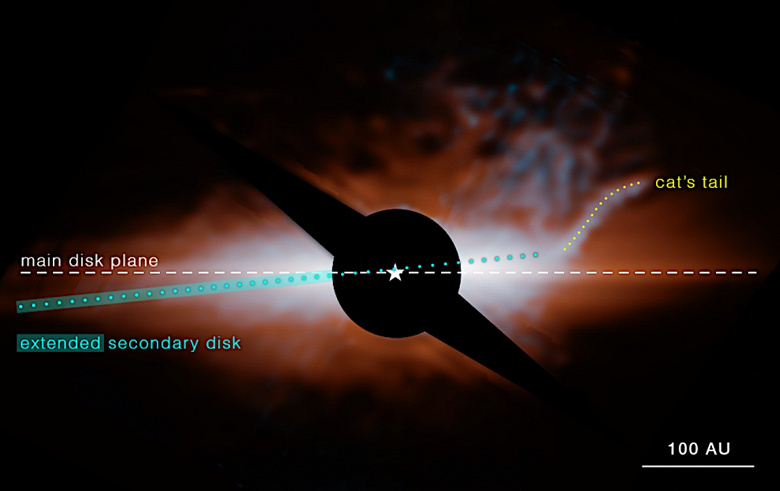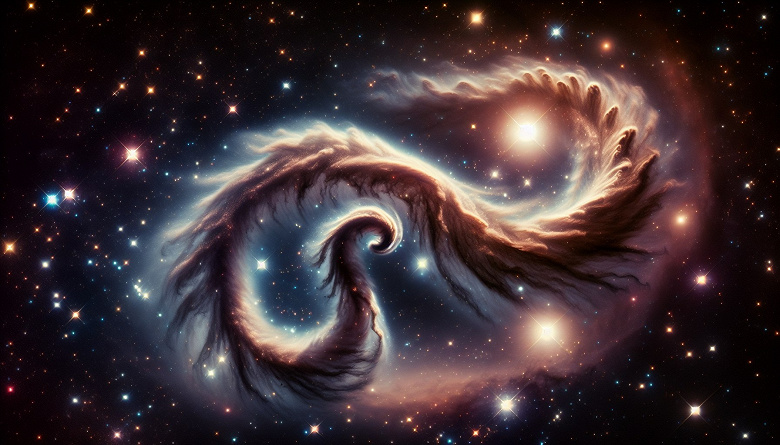The James Webb Space Telescope has discovered an unusual, previously unseen structure in the Beta Pictoris system
Beta Pictoris, a young system located just 63 light years away, continues to captivate scientists with its mystery and unusual features. Researchers have been studying this system for decades and recently made an interesting new discovery.
The first interesting property of «Beta Painter» consists of the presence of a disk fragment of dust. These are debris formed as a result of collisions of asteroids, comets and planetesimals. Hubble Space Telescope made it possible to detect a second disk fragment in this system, inclined relative to the first.
Studying «Beta Painter» continues with the help of the James Webb Space Telescope, which was able to provide new information. A team led by Isabel Rebolido from the Center for Astrobiology of Spain used NIRCam (near-infrared camera) and MIRI (mid-infrared instrument) observations to study the composition of disk debris. The results showed a sharply curved dust tail, reminiscent of a cat's tail.
Rebolido notes: «This system has a whole host of features: a bright star that we can study, and a complex circumstellar environment with many components, including exoplanets and comets. Previously, observations from Earth did not have sufficient sensitivity and spatial resolution, which we now have with the help of “James Webb” instruments, so “tail” remained invisible».

Additionally, the data showed differences in temperature between the two disks, suggesting different material compositions. Stark, a co-author of the study from NASA's Goddard Space Flight Center, says: «We didn't expect that “James Webb” will show us two different types of materials around “Beta Pictoris”, but the data clearly showed that the material of the secondary disk and “tail” heated up more than the main disk material. The dust that makes up this disk and tail should be very dark and therefore not easily visible at visible wavelengths, but it emits in the mid-infrared.
To explain the elevated temperatures, scientists have suggested that the dust may consist of highly porous «organic material» similar to what can be found on the surface of comets and asteroids in our solar system. Preliminary analysis of material from the asteroid Bennu returned by the OSIRIS-REx mission shows it to be very dark and carbon-rich, similar to what was discovered at Beta Pictoris.
However, the question still remains open: what can explain the shape of the «tail», — a unique curved formation, different from disks found around other stars?
Rebollido and her team ran simulations of different scenarios to try to explain the origin of the cat's tail. Scientists have hypothesized that the «tail» arose from an event that happened just a hundred years ago. «For example, a collision occurred, which resulted in the formation of a large amount of dust. At first the dust moved in the same direction as its source, but then it began to spread. The star repels small dust particles faster, and larger “grains” move more slowly, creating a long thread of dust», — says Marshall Perrin, co-author of the study.
«Such a bend — a highly unusual phenomenon, and reproducing it using a dynamic model was difficult. Our model requires that the dust can leave the system quickly, again indicating that it is composed of organic material», — Stark explains.
The preferred model explains the sharp deflection angle of the «tail» from the disk as an optical illusion. The observed angle is created by a combination of our viewing angle and the curved shape, when in reality the arc of material moves away from the disk at an angle of about five degrees. The team estimates the amount of dust in the «tail» as the equivalent of the main asteroid belt, distributed over about 16,093,440,000 kilometers.
A recent dust event in the debris disks may also explain the observed asymmetric expansion of the inner disk, which is visible only in the infrared data and only on the opposite side of the tail. This event could also explain a feature previously discovered by the Atacama Massif in 2014 — accumulation of carbon monoxide (CO) near the «tail». Since the star's radiation should destroy CO in about a hundred years, this accumulation of gas may be a residual trace from this event.
«Our research suggests that “Beta Pictoris” may be even more active and chaotic than we previously thought. “James Webb” continues to surprise us, even when we examine already well-studied objects», — says Stark.

